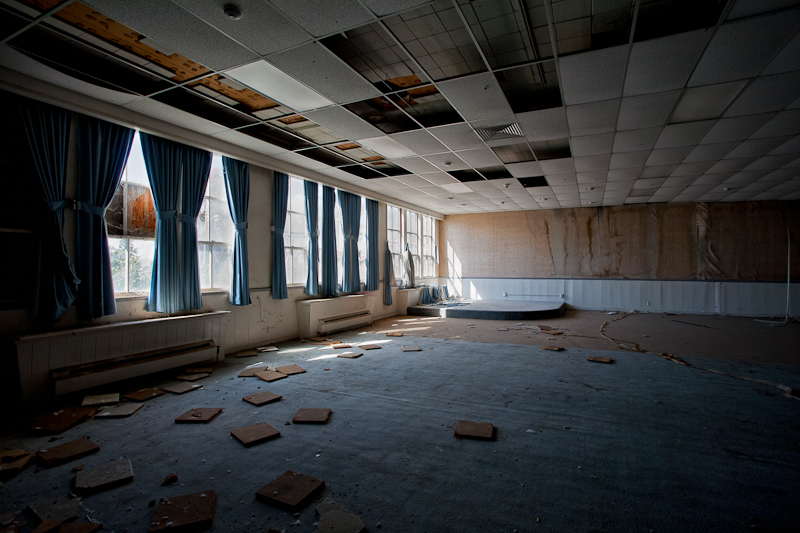USS Iowa (BB-61) at dawn, docked in Richmond, California.
USS Iowa Heads to Southern California
On Saturday, the USS Iowa (BB-61) will be towed from Richmond to her new home in Long Beach. She is the last Iowa Class battleship in existence to become a museum, which will thankfully preserve the ship that served in WWII, carried Roosevelt across the Atlantic in 1943 and suffered a turret exploring in 1989, killing 47 crew members.
Much has changed since this image was taken of her in the Mothball Fleet in January 2010, but my feelings about her still remain the same. She is magnificent.
The first time I set foot on her deck, I was immersed in the history, tragedy and beauty of this ship and though I am sad to see her leave the Bay Area, I am incredibly happy to see such a big part of our history preserved.
U.S.S. Iowa BB-61: Benicia to Richmond
On Thursday October 27, 2011, USS Iowa was removed from the Suisun Bay Mothball Fleet and placed at the Port of Benicia, where she spent one night before beign transferred to Richmond. For the next three months, USS Iowa will undergo significant refurbishment before making the long journey to Berth 87 in Los Angeles where she will become an interactive museum.
The battle this ship has experienced since her decomissioning was politically based and spanned across the past ten years as she sat in Suisun Bay. There was always a push to turn the battleship into a museum in San Francisco, but the Board of Supervisors was against mooring a miliitary ship based on a "homophobic entity" within the confines of the city, which caused other organizations to raise money in the hopes to move the ship to another California dock.
USS Iowa is the last of four remaining battleships of its kind and the last of the four to be turned into a museum. The 887 foot long USS Iowa, built in 1940, was the fastest ship in her class of battleship and the only ship of her class to have served in the Atlantic Ocean during World War II. Her main battery consisted of nine 16"/50 Caliber Mark 7 guns which could fire 2,700lb shells approximately 20 miles.
In 1989, during a gunnery excersise, an explosion occurred in the center gun room destroying Turret #2 and killing 47 sailors.
The ship was decomissioned in 1990 and placed in the Suisun Bay Reserve Fleet short thereafter.
Port of Benicia
Leaving the Port of Benicia
Approaching the Carquinez Bridge
USS Iowa after passing under the Richmond Bridge
Nearing Berth 3 in Richmond
Tugboat pushes USS Iowa towards the pier
Aft guns
Arriving at Berth 3 in Richmond
Flying the US Flag in Richmond
Forward 16"/50 caliber Mark 7 guns
Portside guns, 5"/38 caliber twin turrets
Securing the mooring lines
Crew
Crew
WWII Veteran Joe served aboard USS Iowa during her first deployment in 1942.
Photo: "One Way"
The Presidio of San Francisco was turned over to the United States by the Spanish in 1848. More than one hundred years later, in 1989, Congress voted to end its military operations. In 1994, it was turned over to the National Park Service.
Photo: "Sleeping To Dream"
Abandoned military building in San Francisco's Presidio.
Photo: "Sea Shadow"
For the second time in a month, an article regarding the scrapping of the Sea Shadow has surfaced. Might it be the last attempt to find a non-profit to take the ship?
The Sea Shadow (IX-529) was an experimental stealth ship built for the U.S. Navy in 1984 by Lockheed Corporation, an American aerospace manufacturer. She was constructed in Redwood City, California inside the Hughes Mining Barge to conceal the project. The ship was used in secret to determine the effectivemes of stealth technology on naval vessels. In 1993 the project was publicly exposed.
Photo: "Escape Route"
Deteriorating restroom inside the abandoned Heritage Inn at Rough & Ready Island, a Cold War communications outpost.


Photo: "Duplicity"
The entrance to the Heritage Inn at Rough & Ready Island, a communications outpost for submarine actvities during the Cold War.
Photo: "Transpose"
Rough & Ready Island in Stockton, California served as a major communications outpost for submarine activities in the Pacific during the Cold War. It opened in 1944 and closed in 1996 during the Base Realignment and Closure Commission.
Photo: "Exhibitionist"
Inside a moldy, damp hotel room at the Heritage Inn at Rough & Ready Island, an Inn designed to house the officers, families and visitors to the island. In this particular room, the moldy mattress was hit with a beam of light from the window, causing the mattress to steam and the room to smell like a boiling pot of moldy water.
Photo: "Disconcerting"
Men's restroom inside the Heritage Inn at Rough and Ready Island in Stockton, CA.
Photo: "Threshold"

The Heritage Inn at Rough & Ready Island.
Rough & Ready Island went into operation beginning in 1944. It was also known as NSAS (Naval Supply Annex Stockton), a Navy supply depot and disposal facility that was built as an auxilary location to the Oakland Navy Depot.
Photo: "Porcelain Dancer"

Between 1944 and 1965, the Heritage Inn at Rough & Ready Island, an auxilary location to the Oakland Navy Depot, was built to house officers, their families, and visitors.
Photo: "Dislodged"
Inside the auditorium of the former Heritage Inn on Rough & Ready Island.
Stockton's Rough and Ready Island went into operation in the early 1940's as an auxilary depot to the Navy Depot in Oakland. A few years later, the Heritage Inn was built to house the officers, families and visitors to the island.
Photo: "Depths"
Dry dock #4 at Mare Island Naval Shipyard
On September 16, 1854, Mare Island Naval Shipyard became the first permanent US Navy Shipyard on the West Coast. By 1941, the third drydock had been completed and this dry dock, number four, was in the process of being built.






























